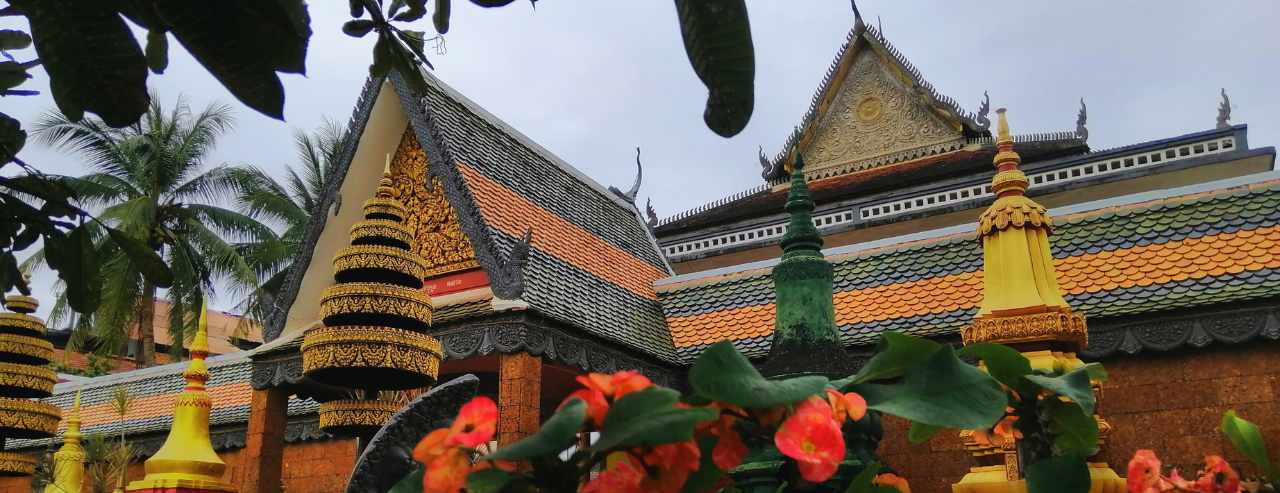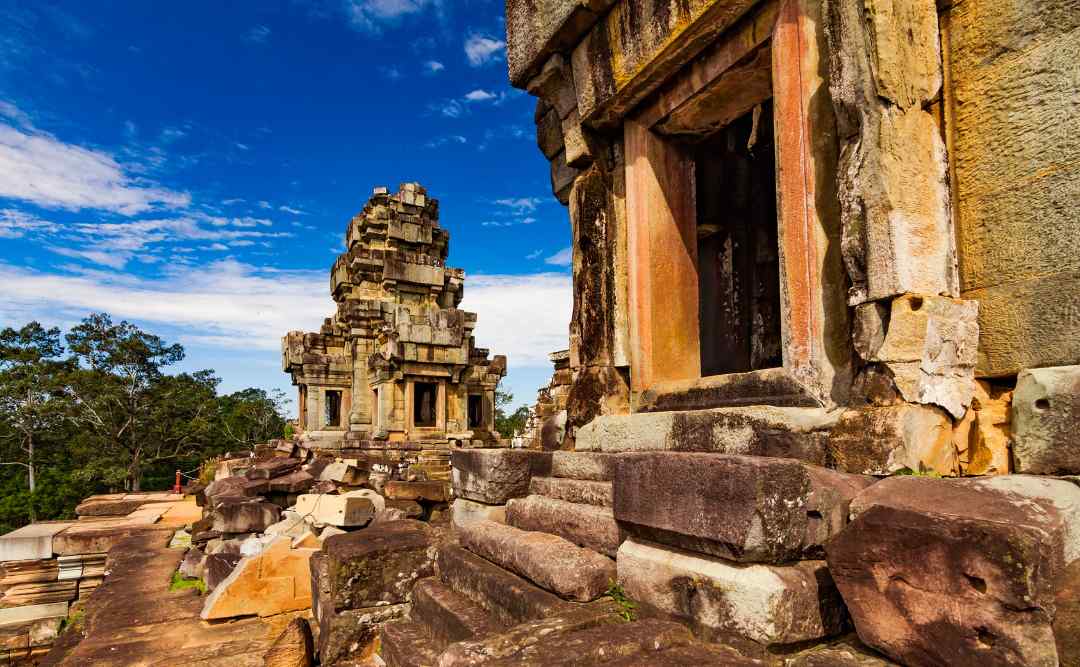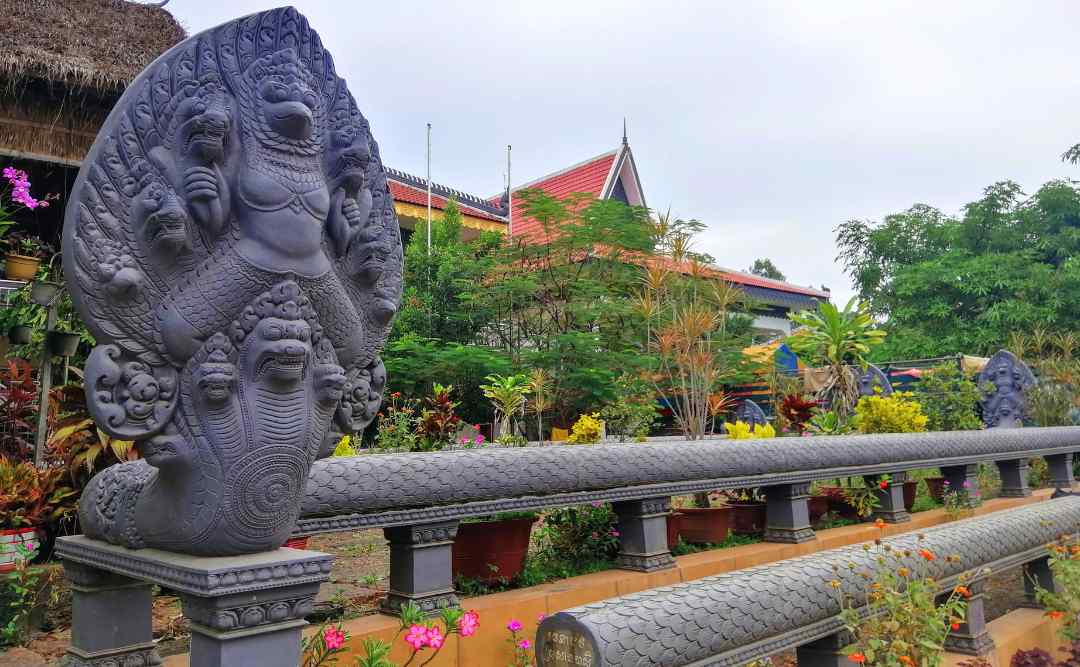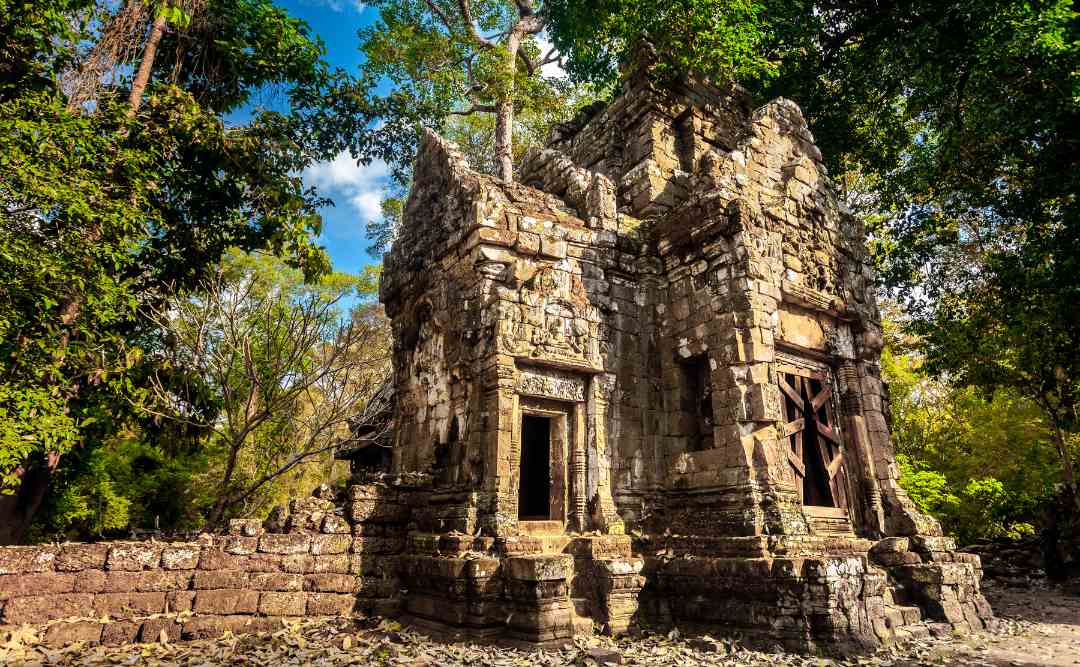Siem Reap History: A Comprehensive Look at How This City Came to Be
Siem Reap history is a fascinating tale of how a small Cambodian village transformed into a bustling tourist destination and gateway to the iconic Angkor Wat temple complex.
Tracing Siem Reap history provides insight into the rise and fall of the ancient Khmer empire, European colonialism, the brutal Khmer Rouge regime, and ultimately, Siem Reap’s modern-day incarnation as the epicenter of Cambodia’s tourism industry.
This Siem Reap history article will highlight key moments and figures that shaped the city into what it is today.
Key Takeaways:
- Siem Reap’s humble beginning as a rest stop on pilgrimage routes to ancient Angkor
- The town’s ties to powerful Khmer rulers who built the iconic Angkor Wat
- Periods of decline, colonial influence, and upheaval from war and genocide
- Resilience of Siem Reap’s local communities through times of hardship
- Modern revitalization as a gateway to Angkor’s temple treasures
- Balance of preserving cultural heritage and developing tourism economy
- Lessons of unity, tradition, and rebuilding from Siem Reap’s storied past
Siem Reap History – The Early Days
The Siem Reap history goes back to the 802 AD, when the area was first settled by the Khmer people. Siem Reap literally translates to “Siem Reap River” in the Khmer language, referring to the tributary of the Tonle Sap Lake that flows through the region. For centuries, Siem Reap remained a small, sleepy village surrounded by dense jungle. Things began to change in the early 13th century, when King Jayavarman VII established the Khmer empire and built the iconic Angkor Wat just north of Siem Reap.
The Rise of Angkor as Siem Reap History
The construction of Angkor Wat ushered in a golden era for both the Khmer empire and Siem Reap. As the expansive temple networks of Angkor were built up over the next few centuries, Siem Reap emerged as a rest stop and trading hub for those traveling to the temples.
The village began to prosper, expanding in lockstep with Angkor’s growing fame and importance.
By the 14th-15th centuries, Siem Reap was a bustling town filled with travelers, traders, and artisans catering to the scores of Hindu and Buddhist pilgrims journeying to Angkor.
The temples brought wealth, prestige, and cultural importance to the previously backwater Siem Reap area.
Siem Reap History Under the French Protectorate
After centuries of regional dominance, the Khmer empire entered a long decline in the 15th century AD. As Angkor fell into ruin, Siem Reap faded back into obscurity as a small provincial outpost. This changed when French colonists took control of Cambodia in 1863, establishing the French Protectorate of Cambodia.
The French were keenly interested in Angkor, and began actively restoring sites like Angkor Wat and the Bayon in the early 1900s. This French-led conservation work sparked a renewed interest in Angkor internationally.
As Angkor’s restoration progressed, the French administration also revitalized Siem Reap, designating it the main gateway to the historic temple complexes. Grand colonial buildings and villas were constructed to accommodate the influx of foreign archeologists, dignitaries, and early tourists journeying to explore Angkor. This investment transformed Siem Reap from a languishing village into a charming administrative center and tourist town.
By the 1920s-30s, Siem Reap was a popular stopover for travelers enamored with the mystique of Angkor.
The renewal of Angkor Wat catalyzed the resurgence of Siem Reap in the early 20th century.
The Khmer Rouge Period
This era of growth was cut short by the dark period of Khmer Rouge rule from 1975-1979. The fanatical communist regime dismantled modern Siem Reap, forcibly evacuating residents to work as slave labor in the countryside. Tourism was completely halted during this time.
Thousands were killed or starved as the Khmer Rouge enacted their radical vision of an agrarian utopia.
When the regime finally fell in 1979, Siem Reap was a shell of its former self – a ghost town with vegetation swallowing up crumbling buildings. It would take tremendous effort to rebuild after this traumatic period.
Angkor Dreams & Beyond – Private Siem Reap 5 day tour of Temples, Villages, and Nature.
Rebirth as a Tourism Hub
After the Khmer Rouge regime ended, Siem Reap faced the monumental task of revival. It was a crowded, impoverished city with little infrastructure.
However, the wonder of Angkor still captured imaginations around the world. Intrepid backpackers began trickling into Siem Reap in the 1980s, eager to be among the first to rediscover Angkor after decades of isolation.
Local entrepreneurs like Dy Proeung built the first guesthouses to accommodate these early visitors.
As word spread of Angkor’s enduring magnificence, tourist numbers slowly grew through the 1980s and 1990s. This ushered in the modern era of Siem Reap’s history, with the city reinventing itself as a tourism and hospitality hub. Luxury hotels, restaurants, tour agencies, and other tourism-related services sprouted up. Conservators continued restoring Angkor’s temples, drawing ever-larger crowds.
In 1992, over 30,000 people visited Angkor. In 2018, this number exceeded 2.5 million. The exponential growth in visitors cemented Siem Reap’s status as the epicenter of Cambodia’s vital tourism industry.
Today, Siem Reap history lives on in the city’s unique blend of provincial charm, colonial architecture, and modern tourism amenities.
The global fascination with Angkor Wat fueled Siem Reap’s rise from obscurity to become the colorful, energetic hub travelers encounter today. Exploring Siem Reap offers a chance to step into the history shaped by this legendary temple complex.
Key Figures in Siem Reap History
The transformation of Siem Reap from a small village into a global tourism destination was driven by key figures that left an indelible mark on the city. Here are some notable personalities who helped shape Siem Reap over the centuries:
Suryavarman II – Angkor’s Architect
No Siem Reap history is complete without the visionary 12th century king Suryavarman II – architect of Angkor Wat. Building the iconic temple dramatically elevated Siem Reap’s importance and prosperity. Angkor Wat anchored an expansive new capital city in the Siem Reap/Angkor area, allowing the village to flourish. Suryavarman II’s ambitious construction projects put Siem Reap on the map.
Henri Mouhot – Popularizing Angkor
French explorer Henri Mouhot played a critical role popularizing Angkor in the mid-19th century. Mouhot came across the mysterious, jungle-shrouded ruins of Angkor in 1859. His writings and sketches documenting the incredible temples galvanized interest in Angkor among Europeans. This eventually drove the French colonists to revitalize Angkor and Siem Reap. Mouhot’s “rediscovery” set changes in motion.
André Malraux – Looter to Conservationist
French author André Malraux made his mark on Siem Reap history in both positive and questionable ways. In 1923, Malraux was caught trying to loot and smuggle priceless Khmer sculptures from Banteay Srei temple. This high-profile case increased awareness of the need to protect Angkor’s heritage. After his trial, Malraux became a prominent advocate for architectural conservation at Angkor, helping secure funding for restoration work in the 1930s-60s.
Vittorio Rosellini – Recording Angkor’s Legacy
Italian scholar Vittorio Rosellini led an expedition to survey and document key Angkor temples in the 1850s. Rosellini’s meticulously detailed maps, plans, sketches, and descriptions played a pivotal role in reconstructing Angkor’s history and guiding future restoration efforts. The voluminous material Rosellini compiled remains an invaluable resource for understanding Angkor and Siem Reap.
Dy Proeung – Siem Reap’s Tourism Pioneer
Dy Proeung was one of Siem Reap’s most influential tourism entrepreneurs. He opened the city’s very first guesthouse in 1963. When foreign visitors trickled back to Angkor in the 1980s, Dy Proeung built more lodgings and restaurants to accommodate these early tourists. Along with Charles de Gaulle and other pioneers, he blazed the trail for Siem Reap’s modern-day tourism scene.
These are just a few of the intrepid explorers, diligent scholars, visionary builders, and ingenious businessmen that have each contributed to molding Siem Reap history through the centuries. Their collective impact shaped the beguiling, bustling gateway city we know today.
Siem Reap History Highlights by Era
Siem Reap history stretches back over a thousand years. Here is an overview of key events and milestones in the transformation of Siem Reap, organized by historical era:
Khmer Empire Era (802 AD – 1431 AD) 802 AD
- First known settlement established in the Siem Reap area by Khmers
- Early 13th century – Siem Reap becomes a stopover for people journeying to Angkor temple city built by King Suryavarman II
- Late 13th century – Chinese diplomat Zhou Daguan visits Angkor/Siem Reap, leaving detailed records about the city
- 14th-15th centuries – Siem Reap grows into a thriving hub for travelers visiting Angkor at its zenith
Post-Angkor Era (1431 AD – 1863 AD)
- 1431 – Final sacking of Angkor by invaders marks decline of Khmer empire
- 1431 onwards – Siem Reap fades from prominence as Angkor is abandoned and falls into ruin
- Mid-19th century – French explorer Henri Mouhot tours Angkor ruins, popularizing them with Europeans
French Colonial Era (1863 AD – 1953 AD)1863
- Cambodia becomes part of French Indochina; French Protectorate of Cambodia established
- Early 1900s – French begin restoring Angkor temples, reviving interest in the area
- 1907 – Grand Hotel d’Angkor built, becoming Siem Reap’s most famous colonial-era landmark
- 1920s-1930s – Siem Reap emerges as getaway for French elite and western travelers coming to see Angkor
Independence & Turmoil (1953 AD – 1992 AD)
- 1953 – Cambodia gains independence from France
- 1960s – Siem Reap airport constructed, improving access for growing tourism
- 1975-1979 – Under Khmer Rouge dictatorship, Siem Reap is forcibly evacuated; tourism completely halted
- 1979 – Vietnamese forces oust Khmer Rouge, beginning a gradual period of rebuilding
- 1980s-1990s – Intrepid travelers start coming to Siem Reap again to see Angkor; town slowly revives
Tourism Expansion Era (1992 AD – Present) 1992
- 30,000 people visit Angkor, signalling resurgence of tourism in Siem Reap
- 1999 – Angkor becomes UNESCO World Heritage Site
- 2000s – Airport expands. High-end resorts established. Tourist numbers skyrocket.
- 2018 – Angkor draws over 2.5 million visitors, cementing Siem Reap as Cambodia’s tourism capital
This timeline provides an overview of the major events and inflection points that crafted Siem Reap history across different eras. From its ancient Khmer roots, through colonialism, conflict, and rebirth as a tourism center, the city has undergone an incredible evolution.
How Siem Reap’s Landscape Changed Through History
Siem Reap’s built landscape and natural geography have changed dramatically over the centuries in tandem with the ebb and flow of its fortunes. Here are some of the most striking evolutions:
Dense Forest to Cleared Settlement
Originally, Siem Reap was enveloped by dense tropical forest, marshlands, and waterways. As the Khmer people settled the area in the 9th century, trees were cleared to build up a fledgling village. 11th-13th century growth turned Siem Reap into a bustling waystation ringed by cultivated rice paddies and farms.
Provincial Town to Colonial City
By the 19th century, Siem Reap was a small provincial Cambodian town centered around a market area. Under French Protectorate rule after 1863, grand European-style buildings and tree-lined boulevards gradually transformed Siem Reap into a genteel colonial administrative center.
Modern Hub Reverts to a Rural Ghost Town
In the 1960s, Siem Reap was modernizing into a gateway city, with an international airport, hotels, and paved roads. The Khmer Rouge gutted this infrastructure in the 1970s, forcibly evacuating people and leaving Siem Reap to be swallowed up by encroaching jungle.
Rural Village to Tourism Hotspot
After the Khmer Rouge regime ended, Siem Reap residents trickled back in 1979-80s to a shell of a town. From these humble beginnings, Siem Reap rebuilt itself into the bustling, modern tourist hub seen today – a process of regeneration reflected in its architecture and landscape.
The landscape changes mirror Siem Reap’s shifting fortunes across various historical eras. Today, the city skillfully balances ancient Khmer roots and French colonial charm with contemporary tourism amenities.
How Angkor Shaped Siem Reap’s Growth
No history of Siem Reap would be complete without exploring the profound influence of the nearby Angkor temple complex on the city’s development.
Siem Reap Origins
Siem Reap literally translates to “Siam Forest River”, likely referencing the Siem Reap river flowing through the original ancient Khmer settlement in the Angkor area. Proximity to Angkor catalyzed Siem Reap’s initial rise.
A Temple Support Hub
From the 12th-15th centuries, Siem Reap evolved into a waystation supplying Angkor’s builders then serving pilgrims journeying to the famous temples. Siem Reap’s fortunes rose and fell in time with Angkor’s prominence.
Rediscovering Angkor, Reviving Siem Reap
After centuries of being lost to the jungle, the renewed global interest in Angkor spurred by colonial-era archeologists resurrected Siem Reap as the gateway city to the temples in the early 20th century.
Tourism Focus
Today, facilitating visitors eager to explore the UNESCO World Heritage temples of Angkor Wat, Bayon, Ta Phrom and beyond remains Siem Reap’s core economic focus and identity. Angkor put Siem Reap on the map.
The awe-inspiring temple cities constructed by the ancient Khmers enabled the transformation of Siem Reap from a minor village into the vital tourism gateway city experienced today.
Private Angkor Wat 2-Day Tour – Private Sunset and Sunrise Guided Angkor Temples Tour
A Lasting Legacy: Reflecting on Siem Reap’s Storied Past
As we reach the end of this exploration through Siem Reap’s long and captivating history, I’m struck by just how much this small city has endured over the centuries.
From its modest beginnings as a Khmer fishing village to the heights of the powerful Angkorian Empire and the trials of war and genocide in the modern era, Siem Reap has seen it all.
Yet throughout the twists and turns of its story, Siem Reap has emerged time and again as a resilient community, a cultural heartland, and a place of incredible natural and manmade wonders.
The ingenuity, artistry and faith of the Khmer people shine through places like the iconic temples of Angkor Wat and Bayon, preserving a vital link to the past even amidst times of turmoil. Siem Reap’s natural splendor, from the lush jungles and meandering rivers to Tonlé Sap Lake’s unique biosphere, offers refuge and sustenance generation after generation.
And the town’s early roots as a rest stop for weary travelers continue to this day, itsSame magical draw bringing visitors from around the globe to experience Angkor and beyond. As I reflect on my own journey through this historic place, I’m grateful for the chance to learn about its heritage firsthand – to wander the ancient temples, witness timeless rural life on the lake, and connect with the friendly locals who give Siem Reap its welcoming spirit.
There are valuable lessons we can take from Siem Reap’s history: the importance of resilience in the face of adversity, the power of culture and tradition to unite a community, and the need to balance modernization with preserving the past.
The Kingdom of Cambodia has known great suffering but also produced some of humanity’s most stunning artistic and architectural achievements. Siem Reap is the gateway to this rich legacy.
By delving into the area’s storied past, we better understand the tapestry of events and people that shaped modern Siem Reap. This vibrant town has endured war, regime changes and the challenges of an emerging nation, yet continues to share its cultural treasures and signature hospitality with the world. For any visitor seeking to experience the mystical wonders of Angkor, gain insight into Cambodia’s ancient and recent history, or simply connect with the friendly local lifestyle, Siem Reap remains a captivating destination like no other.
As a visitor, my time exploring the temples, floating villages and downtown markets afforded me wonderful memories I’ll always cherish. But more importantly, it gave me a glimpse into the soul of this community – one that has overcome tremendous hardship but never lost its spirit. Siem Reap’s past may be long and complex, but its future remains bright.
I’m honored to play even a small part in helping share their unique story with others.
Want to learn more about Siem Reap’s history? Let its colorful history, cultural gems and natural wonders inspire your own journey of discovery there.
Use our contact page to get in touch and start planning your customized Siem Reap itinerary today.
However you choose to experience it, this captivating corner of Cambodia is sure to leave an impression that will stay with you long after your visit ends. Just as it has stayed with me.



